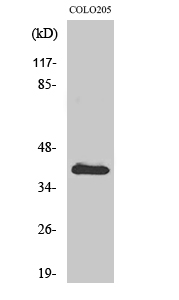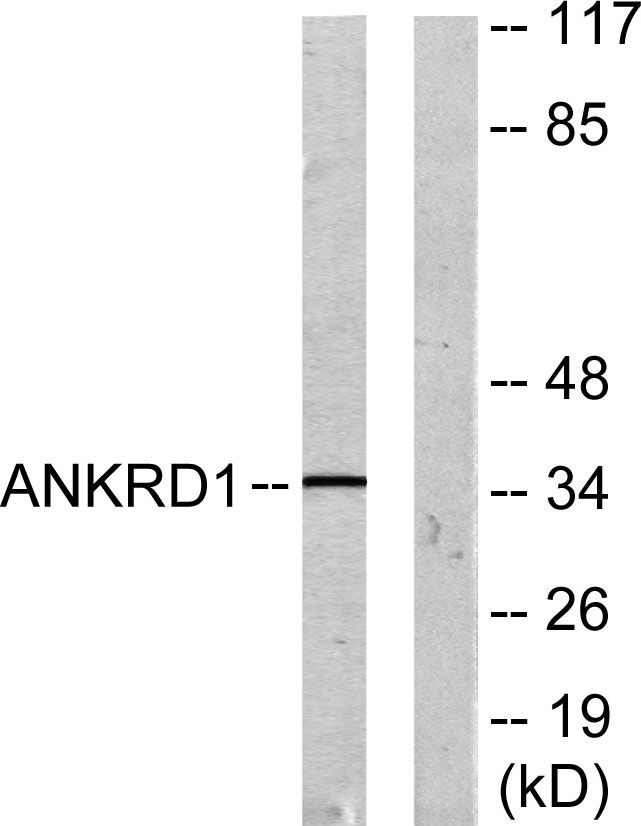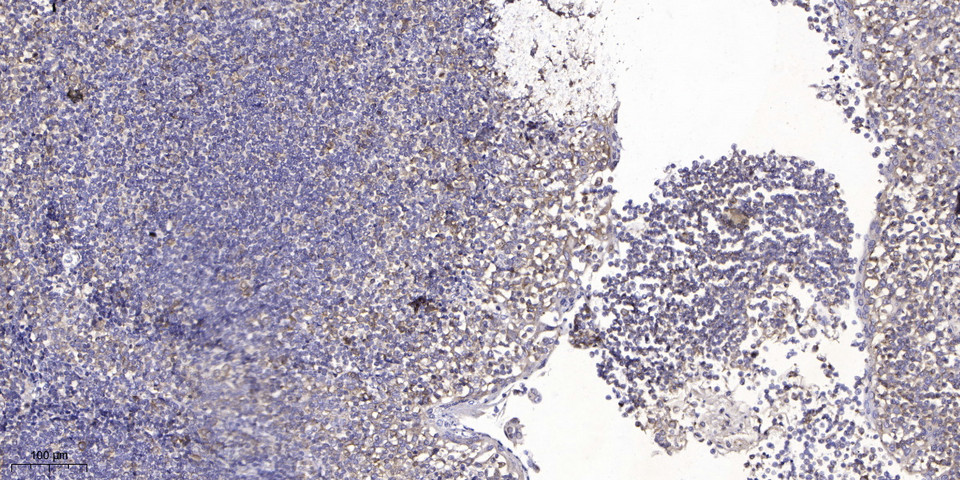CARP Polyclonal Antibody
- Catalog No.:YT0640
- Applications:WB;IHC;IF;ELISA
- Reactivity:Human;Mouse;Rat
- Target:
- CARP
- Gene Name:
- ANKRD1
- Protein Name:
- Ankyrin repeat domain-containing protein 1
- Human Gene Id:
- 27063
- Human Swiss Prot No:
- Q15327
- Mouse Gene Id:
- 107765
- Mouse Swiss Prot No:
- Q9CR42
- Rat Gene Id:
- 27064
- Rat Swiss Prot No:
- Q8R560
- Immunogen:
- The antiserum was produced against synthesized peptide derived from human ANKRD1. AA range:231-280
- Specificity:
- CARP Polyclonal Antibody detects endogenous levels of CARP protein.
- Formulation:
- Liquid in PBS containing 50% glycerol, 0.5% BSA and 0.02% sodium azide.
- Source:
- Polyclonal, Rabbit,IgG
- Dilution:
- WB 1:500 - 1:2000. IHC 1:100 - 1:300. ELISA: 1:20000.. IF 1:50-200
- Purification:
- The antibody was affinity-purified from rabbit antiserum by affinity-chromatography using epitope-specific immunogen.
- Concentration:
- 1 mg/ml
- Storage Stability:
- -15°C to -25°C/1 year(Do not lower than -25°C)
- Other Name:
- ANKRD1;C193;CARP;HA1A2;Ankyrin repeat domain-containing protein 1;Cardiac ankyrin repeat protein;Cytokine-inducible gene C-193 protein;Cytokine-inducible nuclear protein
- Observed Band(KD):
- 36kD
- Background:
- ankyrin repeat domain 1(ANKRD1) Homo sapiens The protein encoded by this gene is localized to the nucleus of endothelial cells and is induced by IL-1 and TNF-alpha stimulation. Studies in rat cardiomyocytes suggest that this gene functions as a transcription factor. Interactions between this protein and the sarcomeric proteins myopalladin and titin suggest that it may also be involved in the myofibrillar stretch-sensor system. [provided by RefSeq, Jul 2008],
- Function:
- disease:Defects in ANKRD1 may be a cause of total anomalous pulmonary venous return (TAPVR) [MIM:106700]. TAPVR is a rare congenital heart disease (CHD) in which the pulmonary veins fail to connect to the left atrium during cardiac development, draining instead into either the right atrium or one of its venous tributaries. This disease accounts for 1.5% of all CHDs and has a prevalence of approximately 1 out of 15'000 live births.,function:May play an important role in endothelial cell activation. May act as a nuclear transcription factor that negatively regulates the expression of cardiac genes. Induction seems to be correlated with apoptotic cell death in hepatoma cells.,induction:By TNF, IL1A and parthenolide.,miscellaneous:A chromosomal aberration in the region of ANKRD1 may be a cause of total anomalous pulmonary venous return (TAPVR) [MIM:106700]. Translocation t(10;21)(q23.31;q11.
- Subcellular Location:
- Nucleus .
- Expression:
- Mainly expressed in activated vascular endothelial cells. To a lower extent, also expressed in hepatoma cells.
- June 19-2018
- WESTERN IMMUNOBLOTTING PROTOCOL
- June 19-2018
- IMMUNOHISTOCHEMISTRY-PARAFFIN PROTOCOL
- June 19-2018
- IMMUNOFLUORESCENCE PROTOCOL
- September 08-2020
- FLOW-CYTOMEYRT-PROTOCOL
- May 20-2022
- Cell-Based ELISA│解您多样本WB检测之困扰
- July 13-2018
- CELL-BASED-ELISA-PROTOCOL-FOR-ACETYL-PROTEIN
- July 13-2018
- CELL-BASED-ELISA-PROTOCOL-FOR-PHOSPHO-PROTEIN
- July 13-2018
- Antibody-FAQs
- Products Images

- Western Blot analysis of various cells using CARP Polyclonal Antibody

- Western blot analysis of lysates from COLO205 cells, using ANKRD1 Antibody. The lane on the right is blocked with the synthesized peptide.

- Immunohistochemical analysis of paraffin-embedded human tonsil. 1, Antibody was diluted at 1:200(4° overnight). 2, Tris-EDTA,pH9.0 was used for antigen retrieval. 3,Secondary antibody was diluted at 1:200(room temperature, 45min).



